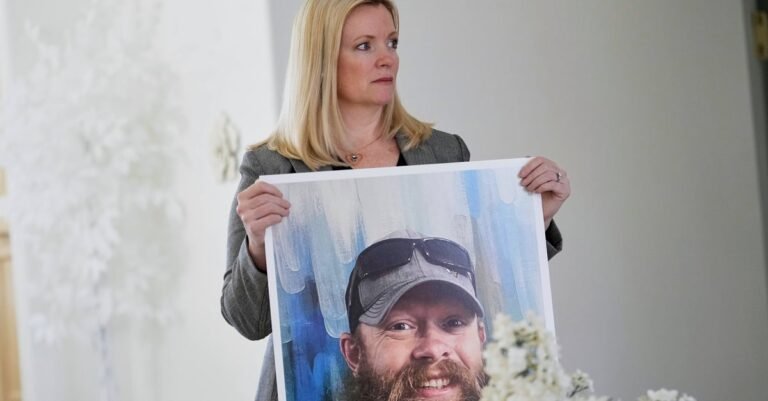CHANDLER, Ariz. (AP) — There have been dozens of statements submitted to the courtroom by household and mates of Christopher Pelkey when it got here time to condemn the person convicted of capturing him throughout a highway rage incident. They offered glimpses of Pelkey’s humor, his character and his navy service.
However there was nothing fairly like listening to from the sufferer himself — on this case, an AI-generated model.
In what’s believed to be a primary in U.S. courts, Pelkey’s household used synthetic intelligence to create a video utilizing his likeness to provide him a voice. The AI rendering of Pelkey informed the shooter throughout the sentencing listening to final week that it was a disgrace they needed to meet that day in 2021 beneath these circumstances — and that the 2 of them in all probability may have been mates in one other life.
“I consider in forgiveness and in God who forgives. I all the time have and I nonetheless do,” Pelkey’s avatar informed Gabriel Paul Horcasitas.
The AI model of Pelkey went on to share recommendation for folks to profit from every day and to like one another, not figuring out how a lot time one may need left.
Whereas use of synthetic intelligence inside the courtroom system is increasing, it’s sometimes been reserved for administrative duties, authorized analysis and case preparation. In Arizona, it’s helped inform the public of rulings in significant cases.
Utilizing AI to generate sufferer affect statements marks a brand new — and authorized, a minimum of in Arizona — device for sharing data with the courtroom exterior the evidentiary phases.
Maricopa County Superior Court docket Decide Todd Lang, who presided over the highway rage case, mentioned after watching the video that he imagined Pelkey, who was 37 on the time of his killing, would have felt that method after studying about him. Lang additionally famous the video mentioned one thing about Pelkey’s household, who had expressed their anger over his demise and had requested for Horcasitas to obtain the utmost sentence.
Horcasitas, 54, was convicted of manslaughter and sentenced to 10.5 years in jail.
“Despite the fact that that’s what you needed, you allowed Chris to talk from his coronary heart as you noticed it,” Lang mentioned.
The Related Press left telephone and electronic mail messages Wednesday looking for remark from Horcasitas’ lawyer.
The capturing occurred the afternoon of Nov. 13, 2021, as each drivers have been stopped at a purple mild. In accordance with data, Pelkey was shot after getting out of his truck and strolling again towards Horcasitas’ automobile.
Pelkey’s sister, Stacey Wales, raised the concept of her brother talking for himself.
For years, whereas the case labored its method by way of the authorized system, Wales mentioned she considered what she would say on the sentencing listening to. She struggled to get phrases down on paper.
However when she considered what her brother would say to the shooter, figuring out he would have forgiven him, the phrases poured out of her.
In Arizona, victims may give their affect statements in any digital format, mentioned victims’ rights legal professional Jessica Gattuso, who represented the household.
Arizona Supreme Court docket Justice Ann Timmer didn’t handle the highway rage case particularly in an interview Wednesday. However she mentioned the rise in reputation and accessibility to AI in recent times led to the formation of a committee to analysis finest practices within the courts.
Gary Marchant, a member of the committee and a regulation professor at Arizona State College, mentioned he understands why Pelkey’s household did it. However he warned the usage of this know-how may open the door to extra folks attempting to introduce AI-generated proof into courtrooms.
“There’s an actual concern among the many judiciary and amongst attorneys that deepfake proof will probably be more and more used,” he mentioned. “It’s simple to create it and anybody can do it on a telephone, and it might be extremely influential as a result of judges and juries, similar to all of us, are used to believing what you see.”
Marchant pointed to a latest case in New York, the place a person with no lawyer used an AI-generated avatar to argue his case in a lawsuit through video. It took solely seconds for the judges to comprehend that the person addressing them from the video display screen didn’t exist at all.
Within the Arizona case, Wales mentioned the AI-generated video labored as a result of the decide had practically 50 letters from household and mates that echoed the video’s message.
“There was a strong gold thread by way of all of these tales — that was the guts of Chris,” Wales mentioned. “This works as a result of it talks concerning the type of particular person Chris was.”
Yamat reported from Las Vegas. Related Press reporter Susan Montoya Bryan in Albuquerque, New Mexico, contributed to this report.

